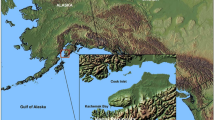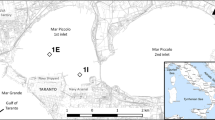Abstract
Detailed surveys of intertidal sediments have been performed along the north and south shores of the Inner Clyde estuary, UK. Surface sediment data reveal significant spatial variation in Cr content and an association with major sediment characteristics and location within the estuary. Depth variation for Cr and other heavy metals cannot be explained by variation in major geochemical controls such as grain size and organic matter and highlights the impact of historical contamination on sediment quality. These elevated levels at depth may still have environmental impact through redox-reactivity, in association with iron and manganese. Sequential extraction of sediments and pore water analysis of Cr(VI) and Cr(III) provide detailed information on release potential from the sediments. The implication of Cr mobility for biota in the estuary has been assessed by the analysis of a common marine bivalve, Mytilus edulis (Blue Mussel) and a burrowing polychaete, Nereis diversicolor (rag worm) from a number of survey sites. Bioconcentration factors for Mytilus indicate that the weakly held portion of sediment Cr is available for uptake and in the case of Nereis, bioaccumulation appears to be inhibited by sediment organic matter.
Similar content being viewed by others

References
Aboul Dahab, O. and Al-Madafa, H.: 1997, Chromium distribution in waters and sediments of the eastern side of the Qatari Peninsula, Science of the Total Environment 196, 1–11.
Abu-Saba, K.E. and Flegal, A.R.: 1995, Chromium in San Francisco Bay: superimposition of geochemical processes causes complex spatial distributions of redox species, Marine Chemistry 49, 189–199.
Balls, P.W., Hull, S., Miller, B.S., Pirie, J.M. and Proctors, W.: 1997a, Trace metal in Scottish estuarine and coastal sediments, Marine Pollution Bulletin 34, 42–50.
Balls, P.W., Owens, R.E. and Muller, F.L.L.: 1997b, Dissolved trace metals in the Clyde, Forth and Tay estuaries-a synopsis and comparison with other UK estuaries, Coastal Zone Topics 3, 46–56.
Baruah, N.K., Kotoky, P., Bhattacharyya, K.G. and Borah, G.C.: 1996, Metal speciation in Jhanji River sediments, Science of the Total Environment 193, 1–12.
Bernds, D., Wübben, D. and Zauke, G.-P.: 1998, Bioaccumulation of trace metals in polychaetes from the German Wadden Sea: evaluation and verification of toxicokinetic models, Chemosphere 37, 2573–2587.
Bothner, M.H., Bucholtz ten Brink, M. and Manheim, F.T.: 1998, Metal concentrations in surface sediments of Boston Harbour-changes with time, Marine Environmental Research 45, 127–155.
Brügmann, L., Hallberg, R. and Larsson, C.: 1998, Trace metal speciation in sea and pore water of the Gotland Deep, Baltic Sea, 1994, Applied Geochemistry 13, 359–368.
Bryan, G.W.: 1980, Recent trends in research on heavy-metal contamination in the sea, Helgolander Meeresutersuchen 33, 6–25.
Bryan, G.W. and Langston, W.J.: 1992, Bioavailability, accumulation and effects of heavy metals in sediments with special reference to UK estuaries: a review, Environmental Pollution 76, 89–131.
Bryan, G.W., Langston, W.J., Hummerstone, L.G. and Burt, G.R.: 1985, A Guide to the Assessment of Heavy Metal Contamination in Estuaries Using Biological Indicators. Occasional Publication No. 4, Marine Biological Association of the UK, Plymouth, 92 pp.
Burt, G.R., Bryan, G.W., Langston, W.J. and Hummerston, L.G.: 1992, Mapping the distribution of metal contamination in UK estuaries, Plymouth Marine Laboratory, Plymouth, 128 pp.
Buykx, S.E.J., Bleijenberg, M., van den Hoop, M.A.G.T. and Loch, J.P.G.: 2000, The effects of oxidation and acidification on the speciation of heavy metals in sulfide-rich freshwater sediments using a sequential extraction procedure, J. Environmental Monitoring 2, 23–27.
Coomber, S.D.W., Gunn, A.M. and Whalley, C.: 1995, Comparison of the partitioning of trace metals in the Humber and Mersey Estuaries, Marine Pollution Bulletin 30, 851–860.
Cooper, D.C. and Morse, J.W.: 1998, Biogeochemical controls on trace metal cycling and anoxic marine sediments, Environmental Science and Technology 32, 327–330.
CRPB: 1986, Annual Report for the Year Ending 1985, Clyde River Purification Board, Glasgow.
Curtis, D.J. and McLean, R.O.: 1997, Changes in the epilithic diatom communities of the Clyde Estuary-an indication of improved water quality? Coastal Zone Topics 3, 115–120.
Curtis, D.J., Figures, J., Matthews, J. and Tatner, P.: 1997, Bird preferred areas in relation to proposed land claim in the Clyde Estuary, Coastal Zone Topics 3, 182–188.
Edgar, P.J., Davies, I.M., Hursthouse, A.S. and Matthews, J.E.: 1999, Biogeochemistry of PCBs in the Clyde: distribution and source evaluation, Marine Pollution Bulletin 38, 486–496.
Edgar, P.J., Davies, I.M., Hursthouse, A.S. and Matthews, J.E.: in press, A preliminary evaluation of geochemical factors controlling the sorption of PCBs to intertidal sediments of the Clyde Estuary, UK, Applied Geochemistry.
Farmer, J.G., Thomas, R.P., Graham, M.C., Geelhoed, J.S., Lumsdon, D.G. and Patterson, E.: 2002, Chromium speciation and fractionation in ground and surface waters in the vicinity of chromite ore processing residue disposal sites, Journal of Environmental Monitoring 4, 235–243.
Figures, J.: 1997, A Study of the Biogeochemistry of Selected Metals in the Clyde Estuary, PhD Thesis, University of Paisley.
Figures, J., Matthews, J.E. and Hursthouse, A.S.: 1997, Comparison of the influence of sediment and diet as sources of metals for diatoms and meiofauna, Coastal Zone Topics 3, 66–79.
Fox, W.M., Johnson, M.S., Jones, S.R., Leah, R.T. and Copplestone, D.: 1999, The use of sediment cores from stable and developing salt marshes to reconstruct historical contamination profiles in the Mersey Estuary, UK, Marine Environmental Research 47, 311–329.
Fung, Y.S. and Lo, C.K.: 1997, Determination of heavy metal profiles in dated sediment cores from Sai Kung Bay, Hong Kong, Environment International 23, 317–335.
Grasshoff, K: 1999, in: Methods of Seawater Analysis 3E, Ehrhardt, M. (ed.), Wiley, Weinheim.
Guo, T., DeLaune, R.D. and Patrick, W.H.: 1997, The influence of sediment redox chemistry on chemically active forms of arsenic, cadmium, chromium and zinc in estuarine sediment, Environment International 23, 305–316
Harper, D.J., Fileman, C.F., May, P.V. and Portman, J.E.: 1989, Aquatic Environmental Protection: Analytical Methods, No. 3, Methods for the Analysis of Trace Metals in Marine and Other Samples, MAFF Publication, Lowestoft, 38 pp.
Hursthouse, A.S.: 2001, The relevance of speciation in the remediation of soils and sediments contaminated by metallic elements-an overview and examples from Central Scotland, UK, Journal of Environmental Monitoring 3, 46–60.
Hursthouse, A.S., Baxter, M.S., Livens, F.R. and Duncan, H.J.: 1991, Transfer of Sellafield-derived neptunium to and within the terrestrial environment, Journal of Environmental Radioactivity 14, 147–174.
Hursthouse, A.S., Iqbal, P. and Denman, R.: 1993, Sampling interstitial waters from intertidal sediments: an inexpensive device to overcome an expensive problem? The Analyst (London) 118, 1461–1462.
Hursthouse, A.S. and Livens, F.R.: 1993, Evidence for the remobilization of transuranic elements in the terrestrial environment, Environmental Geochemistry and Health 15, 163–172.
Hursthouse, A.S., Adamczyk, M., Adamczyk, L., Iqbal, P. and Smith F.J.: 1994, Pollutant behaviour in intertidal sediments of the Clyde Estuary I: preliminary observations of historical trends? Marine Pollution Bulletin 28, 765–767.
Hursthouse, A.S., Iqbal-Zahid, P., Figures, J., Mathews, J., Vaughan, D.H. and Davies, I.M.: 2001, Chromium behaviour in intertidal sediments and pore waters, R. Clyde, UK, Environmental Geochemistry and Health 23, 253–259.
Jones, B. and Turki, A.: 1997, Distribution and speciation of heavy metals in surficial sediments from the Tees Estuary, north-east England, Marine Pollution Bulletin 34, 768–779.
Keith-Roach, M., Day, J.P., Fifield, L.K., Bryan, N. and Livens, F.R.: 2000, Seasonal variations in interstitial water transuranium element concentrations, Environmental Science and Technology 34, 4273–4277.
Kostas, J. and Stasicka, Z.: 2000, Chromium occurrence in the environment and methods for its speciation, Environmental Pollution 107, 263–283.
Lam, M.H.-W., Tjia, A.Y.-W., Chan, C.-C., Chan, W.-P. and Lee, W.-S.: 1997, Speciation study of chromium, copper and nickel in coastal estuarine sediments polluted by domestic and industrial effluents, Marine Pollution Bulletin 34, 949–959.
Langston, W.J.: 1986, Metals in sediments and benthic organisms in the Mersey Estuary, Estuarine, Coastal and Shelf Science 23, 239–261.
Lee, J.-S., Lee, B.-G., Luoma, S.N., Choi, H.J., Koh, C.-H. and Brown, C.L.: 2000a, Influence of acid volatile sulphides and metal concentrations on metal partitioning in contaminated sediments, Environmental Science and Technology 34, 4511–4516.
Lee, B.-G., Lee, J.-S., Luoma, S.N., Choi, H.J. and Koh, C.-H.: 2000b, Influence of acid volatile sulphides and metal concentrations on metal bioavailability to marine invertebrates in contaminated sediments, Environmental Science and Technology 34, 4517–4523.
Loring, D.H. and Rantala, R.T.T.: 1992, Manual for the geochemical analysis of marine sediments and suspended particulate matter, Earth Science Reviews 32, 235–285.
Mendez, N. and Paez-Osuna, F.: 1998, Trace metals in two populations of the fireworm Euruthoe complanata from Mazatlan Bay: effect of body size on concentrations, Environmental Pollution 102, 279–285.
Miller, B.S.: 1991, A Decade of Watching Mussels: Trend Monitoring of Cadmium in a Contaminated UK Estuary, in: Farmer, J.G. (ed.), Heavy Metals in the Environment CEP Consultants Ltd., pp. 199–203.
Miller, B.S.: 1999, Mussels as biomonitors of point and diffuse sources of trace metals in the Clyde Sea Area, Water Science and Technology 39, 233–240.
Miller, B.S. and McGeough, M.M.: 1997, Recent trends in trace metal concentrations in the Garnock estuary, in relation to changes in industrial discharge patterns, Coastal Zone Topics 3, 57–65.
Miller, B.S. and Pirie, D.J.: 1997, The application of the 'mussel-watch' concept to the identification of temporal and spatial trends in contamination of the Clyde Sea area by PCBs. Coastal Zone Topics 3, 98–104.
Miller, B.S., Pirie, D.J. and Redshaw, C.J.: 2000, An assessment of the contamination and toxicity of marine sediments in the Holy Loch, Scotland, Marine Pollution Bulletin 40, 22–35.
Murray, K.E., Cauvet, D., Kybeer, M. and Thomas, J.C.: 1999, Particle size and chemical control of heavy metals in bed sediment from the Rouge River, Southeast Michigan, Environmental Science and Technology 33, 987–992.
Pulford, I.D., Allan, R.L., Cook, G.T. and Mackenzie, A.B.: 1998, Geochemical associations of Sellafield-derived radionuclides in saltmarsh deposits of the Solway Firth, Environmental Geochemistry and Health 20, 95–101.
Rollinson, H.: 1993, Using Geochemical Data: Evaluation, Presentation and Interpretation, Longman Scientific and Technical, Harlow, 353 pp.
Rowlatt, S.M. and Lovell, D.R.: 1994, Lead, zinc and chromium in sediments around England and Wales, Marine Pollution Bulletin 28, 324–329.
Schiff, K.C. and Weisberg, S.B.: 1999, Iron as a reference element for determining trace metal enrichment in Southern California coastal shelf sediments, Marine Environmental Research 48, 161–176.
Simon, N.S., Demas, C. and d'Angelo, W.: 1994, Geochemistry and solid phase association of chromium in sediment from the Calcasieu River and estuary, Louisiana, USA, Chemical Geology 116, 123–135.
Simpson, S.L., Apte, S.C. and Batley, G.E.: 1998, Effects of short-term resuspension events on trace metal speciation in polluted anoxic sediments, Environmental Science and Technology 32, 620–625.
Simpson, S.L., Apte, S.C. and Batley, G.E.: 2000, Effects of short-term resuspension events on the oxidation of cadmium, lead and zinc sulphide phases in anoxic estuarine sediments, Environmental Science and Technology 34, 4533–4537.
Turner, A.: 2000, Trace metal contamination in sediments from UK estuaries: an empirical evaluation of the role of hydrous iron and manganese oxides, Estuarine, Coastal and Shelf Science 50, 355–371.
Ugo, P., Bertolin, A. and Moretto, L.M.: 1999, Monitoring sulphur species and metal ions in salt-marsh pore-waters by using an in-situ sampler, International Journal Environmental Analytical Chemistry 73, 129–143.
Ujevic, I., Odzak, N. and Baric, A.: 1998, Relationship between Mn, Cr, Pb and Cd concentrations, granulometric composition and organic matter content in the marine sediments from a contaminated coastal area, Fresenius Environmental Bulletin 7, 183–189.
Ure, A.M. and Davidson, C.M.: 1995, Chemical Speciation in the Environment, Blackie Academic & Professional, Glasgow.
Wang, W.-X. and Fisher, N.S.: 1999, Delineating metal accumulation pathways for marine invertebrates, Science of the Total Environment 237/238, 459–472.
Wang, W.-X. and Guo, L.: 2000, Influences of natural colloids on metal bioavailability on two marine bivalves, Environmental Science and Technology 34, 4571–4576.
Wang, W.-X., Griscom, S.B. and Fisher, N.S.: 1997, Bioavailability of Cr(III) and Cr(VI) to marine mussels from solute and particulate pathways, Environmental Science and Technology 31, 603–611.
Whalley, C.M., Rowlatt, S., Hursthouse, A.S., Iqbal-Zahid, P., Durant, R. and Vaughan, D.H.: 1999, Chromium speciation in natural waters draining contaminated land, Glasgow, UK, Water, Air and Soil Pollution 112, 389–405.
Author information
Authors and Affiliations
Rights and permissions
About this article
Cite this article
Hursthouse, A.S., Matthews, J.M., Figures, J.E. et al. Chromium in Intertidal Sediments of the Clyde, UK: Potential for Remobilisation and Bioaccumulation. Environmental Geochemistry and Health 25, 171–203 (2003). https://doi.org/10.1023/A:1023201827528
Issue Date:
DOI: https://doi.org/10.1023/A:1023201827528



